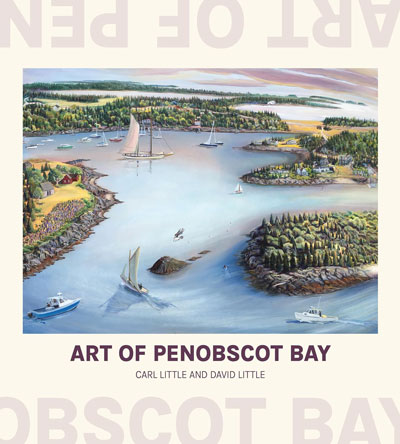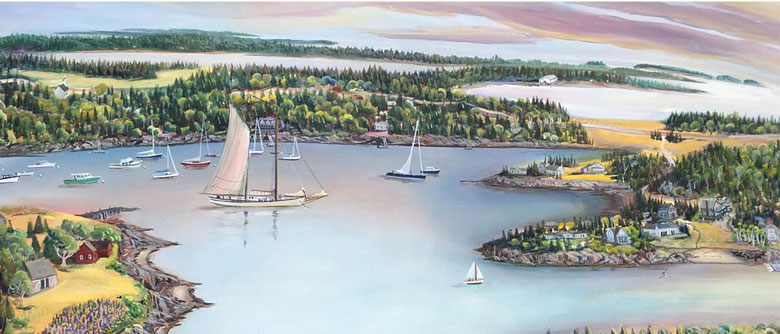Art of Penobscot Bay
By Carl and David Little (Islandport Press)
Looking through Art of Penobscot Bay, Carl and David Little’s latest contribution to Maine art, is like viewing a newly discovered family album. From quiet coves to the clanging metal of an unloading ship, the sights and sounds rendered into watercolor and oil carry an excitement of discovery and of memory.
“Look how commanding the ferry to North Haven seems!”
“Look how the mudflats along the Deer Isle causeway shimmer!”
“And how the low winter sun sets Stonington aglow!”
What a delight to find our everyday vistas thus cherished and transformed by artists.
Poet and writer Carl Little and his brother, the painter David Little, have individually or together celebrated Maine in art through such volumes as Paintings of Maine, Art of Maine Islands, The Art of Maine in Winter, Art of Katahdin, and Art of Acadia. Each is an offering of the region’s beauty and creativity to the world.
Irene Olivieri’s delightful “Studio of the Sea” fancies a lobster boat studio seemingly adrift, with only a cat for a crew…
Art of Penobscot Bay extends this gift into the heart of Maine’s coast from Rockland to Stonington, from the days of schooner traffic to Vinalhaven’s trio of dancing wind turbines.
The book begins with a selection of painters no longer with us (think Fitz Henry Lane, George Bellows, Marsden Hartley), titled “Yesterday,” and moves on to “Today,” featuring those working within the last 70 years. The accompanying narrative notes salient points about artist and image, adroitly linking one to the next.
Many paintings, whether realist, impressionist, or abstract, mesmerize us with the interplay of quiet coves and wider waters, often dotted with sailboats or lobster boats (though very few speedboats).
Yet a pair of images show adolescents so habituated to the bay they have turned their backs to it. Louise Bourne paints her son playing cards on Eagle Island in “Island Solitaire,” while Anina Porter Fuller’s “Game of Chess” portrays two grandsons on Great Spruce Head, the island made famous by her uncles, painter Fairfield Porter and his photographer brother Eliot (both represented in “Yesterday”).
A counterpoint to summer respites are laborers, from William Muir’s 1945 “Fish Packing Plant” to Susan Tobey White’s 2018 “Lobstering Women of Maine,” along with heavier industry, represented by two paintings of Searsport’s Mack Point port, one by Nancy Morgan Barnes, another by Stefan Pastuhov.
Some pages had me laughing aloud. Irene Olivieri’s delightful “Studio of the Sea” fancies a lobster boat studio seemingly adrift, with only a cat for a crew as the naked artist swims atop a seal. In Waldo Peirce’s 1966 “Sirens of Searsport”, five nude women attempt to distract a young lobsterman fiercely rowing his dinghy home.

The late Howard Fussiner comically interprets a Brooksville parade honoring children’s author Robert McCloskey, summer resident of nearby Scott Island. Douglas Smith’s “Fuel Tanks with Lobster, Rockland” is just that, a huge red lobster clawing over a large, white tank.
While “Yesterday” seamlessly edges into “Today,” presenting an almost unchanging coastline, January’s storms battered many of these waterfronts. Seen against those tides, Allen Lawson’s “The Lobster Pound (2006)—Winter” of the popular Lincolnville restaurant, and renderings of Eaton’s boatyard by George Savary Wasson in 1908 and Gregory Dunham in 2015, remind us of the vulnerability of the pastoral coast against the power of these waters we worship.
Given the abundance of Penobscot Bay art, I can only sympathize with the Littles’ effort to limit this volume to 120 artists and 134 paintings. My only concerns are with design and production. An artbook with such a range of artists calls for an index, or at least a list of artists. And the pale blue stripe over one third of each page almost acts as a shadow beside the paintings in the “Today” section.
But the art shines through. For days now, whether gazing out my window or traveling the region, I see an afterglow of possible paintings. Art of Penobscot Bay deepens our vision of this place we inhabit and leads to imagine what might lie within.
Donna Gold gazes at Penobscot Bay daily from her Stockton Springs hilltop home.





